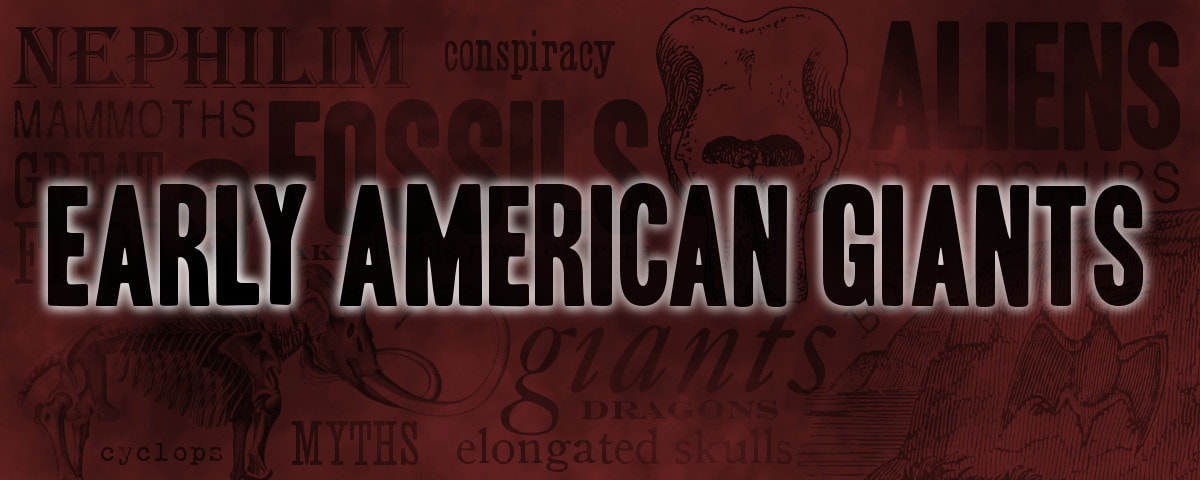Samuel Hubbard
The Los Angeles Times
October 2, 1896
|
NOTE |
Samuel Hubbard, the nephew of the first president of the National Geographic Society, was a banker, corporate director, and later a director of the Oakland Museum. Hubbard returned from the Grand Canyon in 1895 to report that he had discovered the remains of a 20-foot-tall human giant. Paleontologist Charles W. Gilmore of the U.S. National Museum reported on Hubbard’s claims to the National Park Service during the so-called Doheny Expedition of 1924: “When viewed from the bottom of the Canyon, some 75 to 100 feet below the object, [the giant] bore a slight resemblance to the buttocks of a very large man,” but it was nothing more than some smooth rocks that failed to keep up the illusion when one got close enough to it. Besides, the rock was from the Carboniferous Period, long before humans walked the earth. The so-called footprints were simply eroded depressions in the limestone where softer spots had weathered away faster than harder parts of the rock. Hubbard's work is still cited to this day in creationist literature.
(Adapted from my blog post on Hubbard) |
Early American Giants
Does anybody believe that there ever has been a race of giants in the world? Does anybody believe that a race of gigantic men, who were from twelve to twenty feet high, ever lived in these United States of America? And yet the proof that such a race of people did live in this country is to be found in the Grand Canyon of the Colorado River in northern Arizona. This proof consists of, first: Footprints in the red sandstone. Footprints that appear to have been made by the moccasined feet of gigantic men. Men whose tracks measured twenty inches in length and who stepped five feet at a stride.
The second proof is that there is the petrified body of such a man, likewise in the red sandstone of the Grand Canyon district. This body was that of a living, breathing man, but after death the flesh was replaced by lime or silica, held in solution in the water. There is ample evidence that nature was able to perform this feat, as the petrifying process is being carried on in the canyon to this day.
The third fact is that there is and was a strong and almost universal tradition among the ancient people of Mexico and Peru that such a race of giants lived in their country.
Perhaps it is almost too much to call this proof, but it is at least corroborative testimony.
Last June I visited the Grand Canyon as a tourist, taking the Atlantic and Pacific Railroad to Flagstaff, thence by stage seventy miles to the Hance trail on the brink of the gorge. There I met Mr. Hull, who was acting as guide into the canyon, and who was a pioneer of northern Arizona. He told me the following story, and, with apologies for my credulity, I believe him:
Three years ago he and a companion named Jim Lavelle had been prospecting in this part of the country. They found a ledge which they thought was valuable, and had started out of the canyon with samples of the ore, expecting to return in a few days. One of the Indians was with them. Mr. Hull speaks the Indian language fluently, and the Indians have a great admiration for him. The Indian said, “Have you ever seen the big Indian up here?” volunteering to show it. They followed him up a foot trail which led through a crevice in the red wall, thence on to the bench-like formation above, but still in the midst of the red sandstone.
They came to a place where a projecting rock formed a shelter over a sloping table-like slab of stone which was covered with a white incrustation of lime. Outstretched on this slab was the body °f a gigantic man turned into stone. The body was entirely nude and lay face downward. They estimated his height to be eighteen or twenty feet. The left arm was out at full length, while the right arm was doubled under his head. The left leg was perfect, but the foot was jammed into a crack in the slab. The right leg was broken off just below the knee, and the broken part was missing. They looked at it ten or fifteen minutes, and then continued their journey, intending to return and make a more complete investigation. Plans changed, and they failed to return.
Mr. Hull told the story to several people, but they either disbelieved him or discouraged him, so it happened that he had never been back there, and that he had never tried to do anything with his discovery.
He also told me that reliable Indians had described to him tracks of both men and animals in the solid rock not far from this body, and in the same formation. These he had never seen, but he had no doubt of their existence.
This was startling information, but I had been in a measure prepared for it. In the first place, it had always seemed reasonable to me that the prehistoric, primeval hunting savages should have been of large stature. Gregory tells us that there was a period in the history of the world called the Tertiary or Mammalian age that was peculiarly favorable to animal life. It is the age of the mammoth, the great cave bear, the cave lion, the woolly rhinoceros, the primeval ox, the great Irish elk, the gigantic sloths and other familiar animals that were far larger then than now. Was man to be left out entirely amid all this list of giants?
The second proof is that there is the petrified body of such a man, likewise in the red sandstone of the Grand Canyon district. This body was that of a living, breathing man, but after death the flesh was replaced by lime or silica, held in solution in the water. There is ample evidence that nature was able to perform this feat, as the petrifying process is being carried on in the canyon to this day.
The third fact is that there is and was a strong and almost universal tradition among the ancient people of Mexico and Peru that such a race of giants lived in their country.
Perhaps it is almost too much to call this proof, but it is at least corroborative testimony.
Last June I visited the Grand Canyon as a tourist, taking the Atlantic and Pacific Railroad to Flagstaff, thence by stage seventy miles to the Hance trail on the brink of the gorge. There I met Mr. Hull, who was acting as guide into the canyon, and who was a pioneer of northern Arizona. He told me the following story, and, with apologies for my credulity, I believe him:
Three years ago he and a companion named Jim Lavelle had been prospecting in this part of the country. They found a ledge which they thought was valuable, and had started out of the canyon with samples of the ore, expecting to return in a few days. One of the Indians was with them. Mr. Hull speaks the Indian language fluently, and the Indians have a great admiration for him. The Indian said, “Have you ever seen the big Indian up here?” volunteering to show it. They followed him up a foot trail which led through a crevice in the red wall, thence on to the bench-like formation above, but still in the midst of the red sandstone.
They came to a place where a projecting rock formed a shelter over a sloping table-like slab of stone which was covered with a white incrustation of lime. Outstretched on this slab was the body °f a gigantic man turned into stone. The body was entirely nude and lay face downward. They estimated his height to be eighteen or twenty feet. The left arm was out at full length, while the right arm was doubled under his head. The left leg was perfect, but the foot was jammed into a crack in the slab. The right leg was broken off just below the knee, and the broken part was missing. They looked at it ten or fifteen minutes, and then continued their journey, intending to return and make a more complete investigation. Plans changed, and they failed to return.
Mr. Hull told the story to several people, but they either disbelieved him or discouraged him, so it happened that he had never been back there, and that he had never tried to do anything with his discovery.
He also told me that reliable Indians had described to him tracks of both men and animals in the solid rock not far from this body, and in the same formation. These he had never seen, but he had no doubt of their existence.
This was startling information, but I had been in a measure prepared for it. In the first place, it had always seemed reasonable to me that the prehistoric, primeval hunting savages should have been of large stature. Gregory tells us that there was a period in the history of the world called the Tertiary or Mammalian age that was peculiarly favorable to animal life. It is the age of the mammoth, the great cave bear, the cave lion, the woolly rhinoceros, the primeval ox, the great Irish elk, the gigantic sloths and other familiar animals that were far larger then than now. Was man to be left out entirely amid all this list of giants?
Source: Reproduced from the August 15, 1901 edition of Christian Knowledge. The article was widely reprinted in newspapers across the country from 1896 to 1903, with most reprints occurring between 1900 and 1901, largely without the editors’ understanding that the piece was already five years old.



